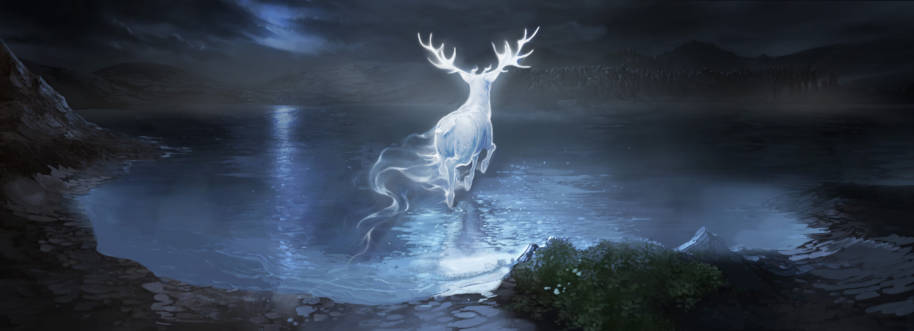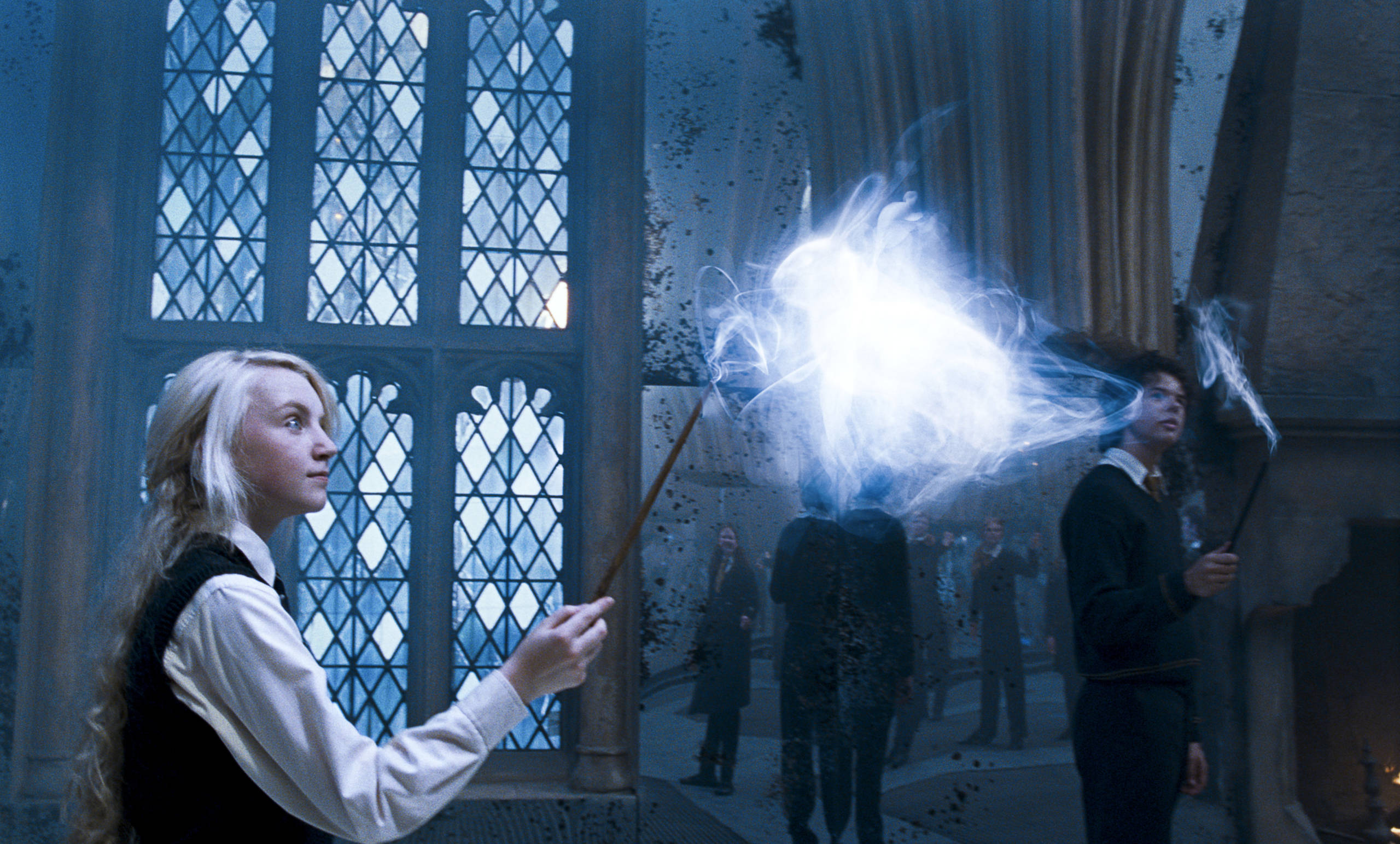
A Patronus is intrinsically tied to a witch or wizard’s personality, although it doesn’t always take the animal form they’d expect. For example, it’s quite unusual for it to be the caster’s favourite animal, but very possible that it will take the shape of a creature they’ve never before seen or heard of.
But what do they mean? It all comes down to interpretation. Fortunately, we Muggles have been practising animal symbolism for centuries and many of the Patronuses cast by the Harry Potter characters have been significant creatures in myth, folklore, religion and literature.
Let’s look at the Patronuses belonging to five proud members of Dumbledore’s Army and see what we can deduce about some of these characters…
Stag (Harry Potter)

‘Is it true,’ interrupted the girl with the long plait down her back, looking at Harry, ‘that you can produce a Patronus?’
There was a murmur of interest around the group at this.
‘Yeah,’ said Harry slightly defensively.
Harry Potter and the Order of the Phoenix
Harry’s ability to produce a corporeal Patronus inspired students to sign up for the then unnamed Dark Arts defence club. As its leader, the stag was a fitting symbol.
Traditionally seen as ‘King of the Forest’, the stag is the protector of the other animals. Harry helps his schoolmates by teaching them everything he knows about defensive magic and frequently throws himself in danger to save others, like Gabrielle Delacour in the Great Lake or Sirius Black at the Department of Mysteries. As Hermione put it, Harry did have ‘a bit of a saving-people thing’ going on.
The stag has other symbolic meanings. As its antlers fall off and regrow annually, it is considered a symbol of rebirth and resurrection. Quite appropriate – Harry is, after all, the Boy Who Lived.
Harry’s parents also shared deer-shaped Patronuses: a stag for James and a doe for Lily. Both died while trying to protect the ones they loved. As Harry’s greatest wish was to have his family back, his Patronus brought them closer in some small, symbolic way.
Otter (Hermione Granger)

Hermione’s talent with a wand was clear from her earliest lessons – swish and flick, it’s all in the wrist. Her Patronus, the otter, is a clever and dexterous animal; some have even been known to juggle small rocks. Otters have also featured in many classics of English literature such as Tarka the Otter, Ring of Bright Water and The Wind in the Willows. Trust Hermione’s Patronus to be in so many books.
But the otter also reflected an aspect of Hermione we weren’t used to seeing. According to the eighteenth-century Charms researcher Professor Catullus Spangle, the Patronus ‘represents that which is hidden, unknown but necessary within the personality’. To face something as evil as a Dementor, a person ‘must draw upon resources he or she may never have needed, and the Patronus is the awakened secret self that lies dormant until needed.’
Hermione’s carefree side was usually buried beneath endless stacks of homework, yet her Patronus animal frolicked around playfully without a care in the world.
Hermione’s Patronus, a shining silver otter, was gambolling around her. ‘They are sort of nice, aren’t they?’ she said, looking at it fondly.
Harry Potter and the Order of the Phoenix
Jack Russell terrier (Ron Weasley)

‘If you want to kill Harry, you’ll have to kill us, too!’ he said fiercely, though the effort of standing up had drained him of still more colour, and he swayed slightly as he spoke.
Harry Potter and the Prisoner of Azkaban
Terriers are small dogs that seriously overestimate their own size and strength. Utterly fearless, they’ll bark furiously at anything they see as a threat, no matter if the odds are against them. Ron Weasley often showed this trait, by protecting Harry from an escaped convict while standing on a broken leg and defending Hermione’s honour with a broken wand, which resulted in an unfortunate bout of slug-vomiting.
Stubborn and wilful as the Jack Russell can be (remember Ron’s epic sulk during Goblet of Fire?), a dog Patronus is a surefire sign of a loyal friend. Take Sirius Black for example, a character most in tune with his canine side. Sirius was extremely loyal to his friends, his cause and to his godson Harry, whom he fought with until the end. Even if Ron went off in the odd huff, he always came back with a new-found ferocity. Man’s best friend indeed.
Hare (Luna Lovegood)

‘I think they think I’m a bit odd, you know. Some people call me “Loony” Lovegood, actually.’
Harry Potter and the Order of the Phoenix
The phrases ‘mad as a March hare’ might well have described Luna Lovegood, who had an interesting relationship with her Patronus. The hare has a strong association with the moon, with the ‘moon gazing hare’ being a symbol in ancient pagan beliefs. How interesting that Luna’s name is of Latin origin, meaning moon.
Though some Patronuses reveal a hidden or repressed quality in the caster, Luna always seemed to be fully in tune with her emotions. Her nickname, ‘Loony’, comes from the word ‘lunatic’ or ‘lunacy’ – a condition once believed to be caused by the full moon. Her Patronus shows that she’s proud to be herself, no matter what anyone else says.
Another character whose Patronus closely resembled the hare was Nymphadora Tonks, whose original Patronus form was a jackrabbit. Like Luna, Tonks was a free spirit who didn’t care what people thought of her attitude, fashion style or wild hair colours. Of course, her Patronus changed (as they sometimes do) once she fell in love with Remus Lupin, becoming a wolf.
Boar (Ernie Macmillan)

Ernie Macmillan stood up at the Hufflepuff table and shouted, ‘And what if we want to stay and fight?’
Harry Potter and the Deathly Hallows
Ernie might have been a bit of a pompous Prefect at times; Harry wasn’t impressed with his attitude during the whole ‘Heir of Slytherin’ thing and nothing he said seemed to change Ernie’s mind. You might even say he was being a bit ‘pig-headed’.
But at heart, Ernie Macmillan was a brave soul, as demonstrated by his eagerness to join the fray at the Battle of Hogwarts. He used his boar Patronus during the battle to help save Harry, Hermione and Ron. As the boar symbolises the warrior in many cultures, it seems right that Ernie helped lead the charge at Hogwarts.
So, do you agree? Or do you have some Patronus theories of your own?
And remember, you can seek your own Patronus out right here.


